This cache is located within Salter Park,
which was the original property for the East Side Drive-In.
Please respect and observe that the park closes at 10:00pm.
Most Drive-In Movie Theaters consist of a large outdoor screen (either a wall painted-white, or a complex steel-truss structure with a complex finish), a projection booth, a concession stand and a large parking area for automobiles. Within this enclosed area, customers can view movies from the privacy and comfort of their cars.

The original Patent Drawings.
The idea originated in the early 1930's in Camden, NJ. and was Patented by Richard M. Hollingshead. His idea began as an experiment in his driveway with a Kodak Projector, mounted on the hood of his car, aimed at a screen that was attached to some trees. He tried different techniques and finally worked-out the parking-arrangement and spacing to allow everyone that attended, an unobstructed view of the screen. Once he had this idea in- place, he was granted a Patent in 1933 and He opened his first Drive-In Theater soon thereafter. This facility only lasted a few years before closing, but the idea caught-on elsewhere to become part of the American Pop-Culture and Landscape to-this-day.

Typical-style of Drive-In Theater Speakers with the Volume Knob.
Sound was originally produced from Speakers in the main screen tower, but the quality wasn't that good and many attempts were made to improve it. In 1941, the RCA corporation found a solution and along-came the in-car speakers with built-in volume controls that most drive-in patrons would come to know. These were better than the original Sound, but still had a very "tinny" sound to them. Later-on, as the technology improved, this system was replaced with Radio Broadcast equipment to allow the sound to be transmitted directly to the vehicles. This was an improved process for sound and also kept damage to the wired Speakers and/or patrons cars that would happen when folks would leave, after a good show of their favorite film, and some people would "forget to remove the speaker" and damage both the speaker and/or their cars in the process (i.e. Windows, or scratches/dents, etc.).
The popularity of the Drive-In's soared after World War II and peaked in the 1950's and 1960's. The theaters would provide cheap, family entertainment including many having a Playground (or other things) for their youngest patrons. For colder-weather, in-car heaters were also offered at many Theaters, much like the Speakers had been.
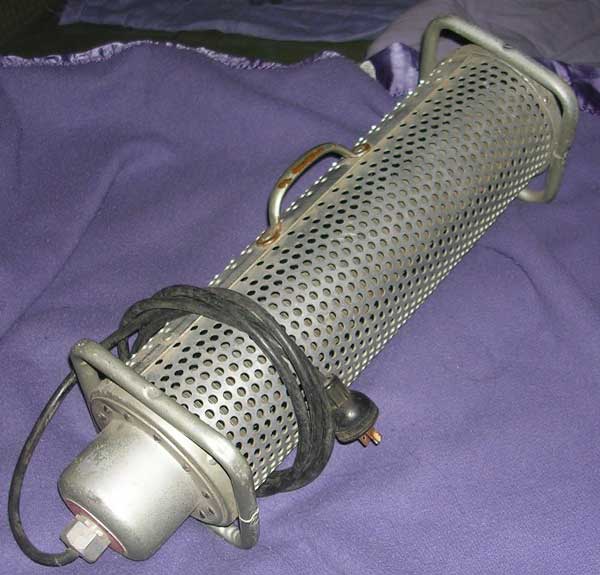
This type of heater plugged in to 120vAC (not 12V car power)
to warm your car during cold nights at the drive in movie.

An "intermission cartoon" to entice patrons to the Concession Stand.

Another Intermission Ad
To this day, food revenue remains extremely important to exhibitors, especially with film rental rates going as high as 80% on opening weekends for some features. In order to promote the concessions, most locations used the now-famous drive-in intermission films, popularized by the Filmack Company, featuring dancing hot dogs and countdown clocks that were supposed to mesmerize the audience members, wet their pallets and open their wallets.
Many Theaters even had "car-hops" like their Drive-In Restaurant counterparts to make the experience even more appealing for their patrons.

A car-hop, taking an order (California)
The Drive-In owners would later allow other-uses for their large amounts of space which could only be used for the Theater after-sunset. This would usually generate more income for the theaters and some of these uses included Flea Markets, Swap Meets, and even Outdoor Church Services.
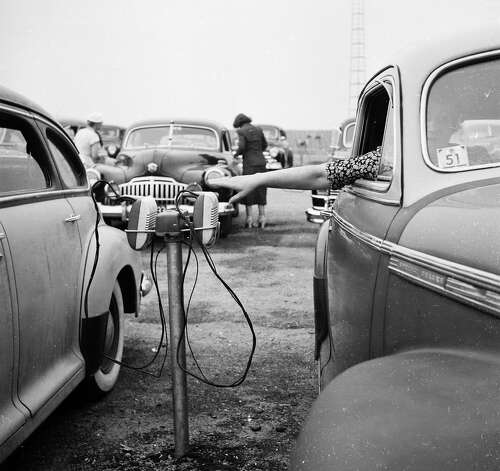
A woman reaches for a car speaker at a drive-in church in Massachusetts in 1951.
Over time, with the advent of other sources of entertainment, as well as the rising cost of Real Estate and other economic factors, Cinematic Landmarks such as these have been slowly disappearing over the years, leaving less than 500 across the United States currently.
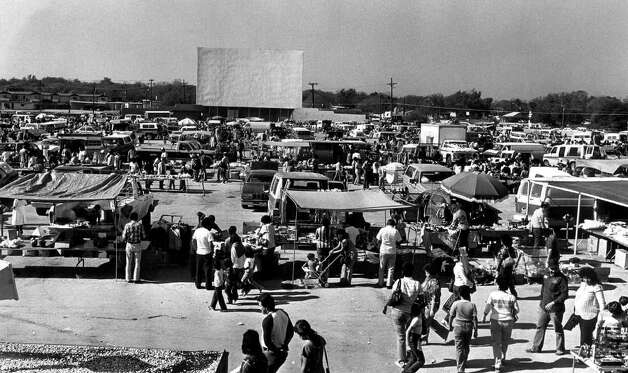
A typical Flea Market at the Mission Drive-In, San Antonio, Texas, 1984
Many of those which were closed were later demolished and the real-estate used for other things such as Office or Retail Space, with some being replaced on the exact same land with Mutli-Plex indoor Movie Theaters. Some properties have just been left vacant with nothing remaining there but an empty field. However, a very-select few that were closed have even re- opened to be given a new-life with new patrons looking for a very unique movie-going experience.
Many folks feel that these Gems of Americana are very much an endangered part of the landscape. Most, if not all of them, have very fond memories of their time spent there and would love to be able to revisit their favorite Drive-In Theater once again.
Michigan Cinema History:
The East-Side Drive-In Theatre
(aka: "the Drive In")
19440 Harper Ave., Harper Woods, MI
(updated June 24, 2013)
OPEN: May 26, 1938 | CLOSED: 1978 | CAPACITY: 970 - 1000
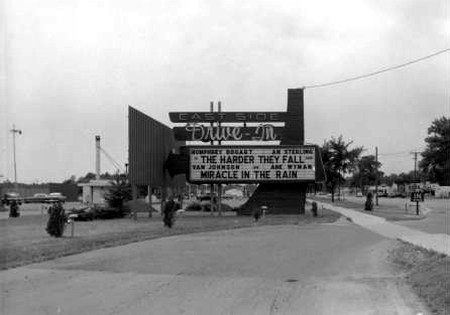 The Marquee from the East Side Drive In (1956)
The Marquee from the East Side Drive In (1956)
The East-Side Drive-In theater opened on May 26, 1938 as Metro Detroit's, possibly the Midwest's, first Drive-in Theater. At that time, it was first simply known as "The Drive In" and the name "East-Side" was later given to the theater when other Drive-ins were built around the area.
 The first movie shown at "The Drive In"
The first movie shown at "The Drive In"
(later known as "The East Side Drive in")
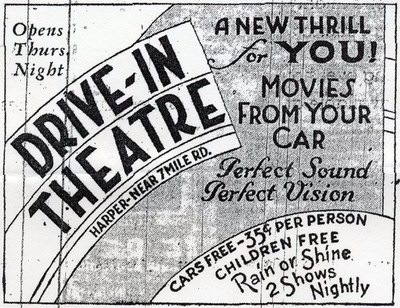 One of the ads that ran to announce the Opening Night.
One of the ads that ran to announce the Opening Night.
Some of the opening newspaper ads read: "Dress as you please... Smoke... Laugh... Take refreshments... without disturbing others... World's Largest Screen" was the promise.
It was also billed as "Detroit's First Open Air Auto Theatre" and Detroiters, like Americans everywhere, liked the idea.
Before the neighborhood was built-up, you could even drive along Moross (also known as 7 mile road) and see the movie playing. Supposedly it was even clear from almost a mile away. If you got close-enough, you could even hear the movie sound coming from the outdoor speakers.
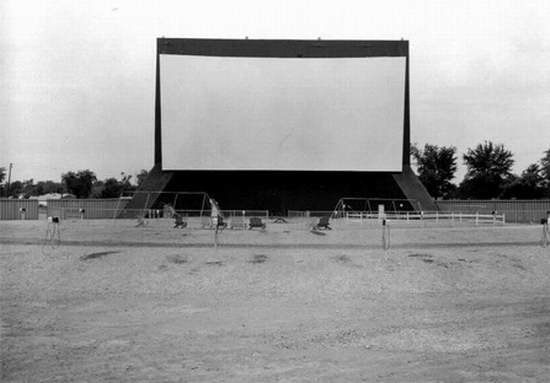
Main Screen from the East Side Drive In, 1956
To entertain the children, there were swings and playground things here to keep them busy.
In later years, the only major changes to the theater were when The marquee and box office were moved next to the screen when I-94 was built next to the drive-in.
Like many of the Drive In Theatres that were constructed and trying to stay popular with their customers, they were trying to attract and keep a family-atmosphere for their shows.
After little more than half a century, an era of the Drive-In Theatre ended. Most people that visited Drive In's consider themselves lucky. Most don’t remember what movies they saw but many of them do remember how exciting it was to be outside late at night, loading up at the snack bar and then then trying not to fall asleep while watching the flickering movie screen from the comfy backseat of the car.
One theater goer summed up her feelings. "You just worry sometimes that it will be all gone. We felt so sorry to see those others all go. We really enjoyed this place."
Until 2012, the only physical reminders of anything being here besides a park were the tall solid metal fences that used to run along the southern perimeter of the Drive-In...but those unfortunately have been removed and everything that was the "East Side Drive-In" is now but a memory.
Many folks feel that the Drive-in Theater is a part of an Endangered Americana that is missed by all who treasured the times that they had there due to both the places that are no longer there, as well as those times being shared with the PEOPLE that we shared them with.
IF you have any good-memories or stories of the East-Side Drive-In Theatre, please feel free to share in your logs.
Reminder:
This cache is located within Salter Park,
which was the original property for the East Side Drive-In.
Please respect and observe that the park closes at 10:00pm.
Enjoy the Hunt...and beware of your surroundings, as always. :)